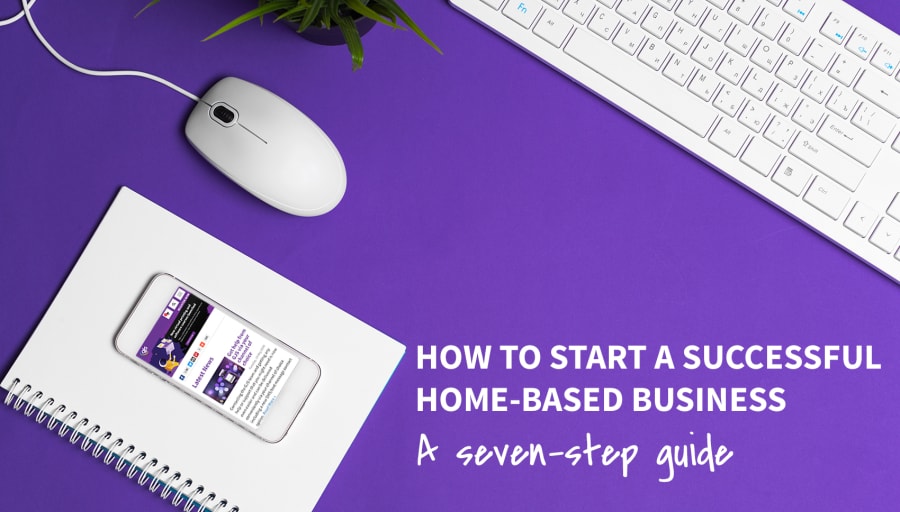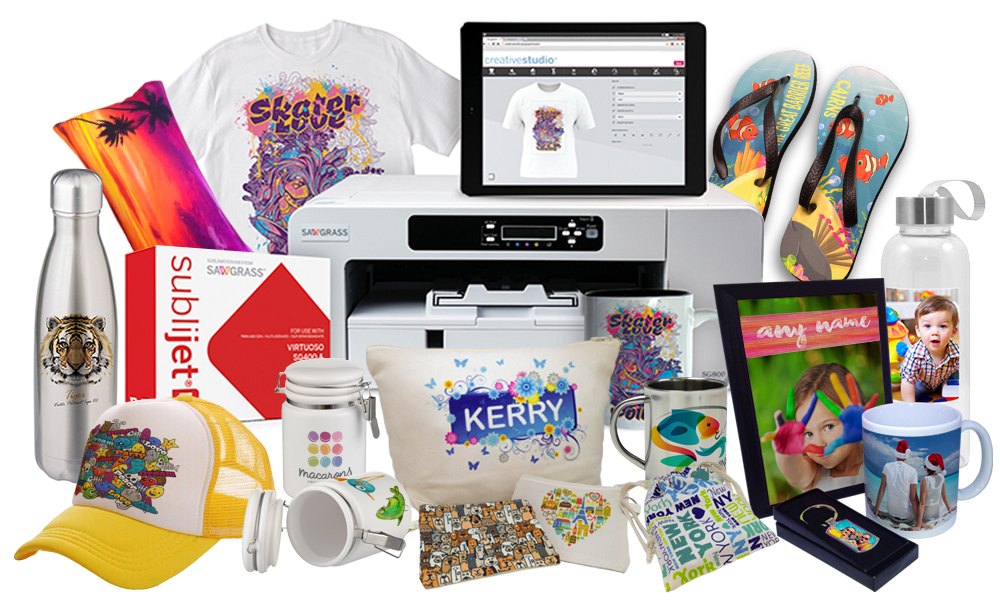7 steps to starting a successful home-based business

SYDNEY, Australia - May 22, 2020
Staying at home? Stood down from your regular job? Start earning money today with a digital decoration business based on either dye sublimation, heat transfer vinyl or direct-to-garment technology.
Whilst many people would like to be free of the shackles of the corporate world and be their own boss, running a business is more than just working for yourself, it's also about having the necessary management skills, industry expertise, technical skills, finance and long-term vision to grow and succeed.
Step 1: Analyse your idea
 If you are just starting out, begin by thinking about the type of products that you would like to create and then do some research to determine if there is actually a demand for those products.
If you are just starting out, begin by thinking about the type of products that you would like to create and then do some research to determine if there is actually a demand for those products.
It is also useful to find out if there are any other businesses in your local area that are creating similar products or offering similar services.
Some questions to consider are:
- What product/service will you provide?
- Is your idea viable?
- Is there a market for your product/service?
- What skills do you need?
- Who are your competitors?
- What difference will you bring to the market?
- What will you do differently to your competitors so that you stand out from the crowd?
Once you've conducted research into the feasibility of your new business, you're ready to write your business plan. Depending on your business type, your plan could include the following sections:
- Business Summary: a one-page overview written after your business plan is finalised
- About your business: this is typically called the management plan or operations plan. It covers details about your business including structure, registrations, location and premises, staff, and products/services
- About your market: this is the marketing plan. It should outline your marketing analysis of the industry you are entering, your customers and your competitors. This section should also cover your key marketing targets and your strategies for delivering on these targets
- About your future: this section covers your plans for the future and can include a vision statement, business goals and key business milestones
- About your finances: the financial plan includes how you'll finance your business, costing and financial projections
Step 2: Invest in the correct technology
Once you have decided what products you’d like to create, it’s important that you then pick the correct technology that will allow you to create the products that you intend to sell.
Dye sublimation transfer technology
 If the creation of promotional products or personalised gifts such as mugs, caps, keyrings and high-definition photographic products is your then dye sublimation transfer technology is a technology that you should consider.
If the creation of promotional products or personalised gifts such as mugs, caps, keyrings and high-definition photographic products is your then dye sublimation transfer technology is a technology that you should consider.
As one of the cheapest and easiest options for starting a successful home-based business, GJS makes it simple to get up and running with three dye sublimation starter kits to select from that including everything you need as well as a selection of our most popular printable blank products.
 Heat transfer vinyl (HTV)
Heat transfer vinyl (HTV)
If you are looking to create logos, text and other complex designs on a variety of garments including sporting apparel and high-vis workwear, then you might consider heat transfer vinyl as your entry point into the market.
GJS has many customers who have bases the successful home-based businesses on heat transfer vinyl technology and many more who have gone on to find a specific niche such as Melbourne-based sporting apparel company, Masita.
 Direct-to-garment (DTG) printing
Direct-to-garment (DTG) printing
If your goal is to create your own t-shirt printing business or fashion label, then perhaps consider the investment in a direct-to-garment or DTG printing solution.
Whilst DTG printing usually has a higher upfront investment, it is more economical, faster, and cleaner than traditional screen printing, and has lower overall print costs compared to the above solutions.
You can create one of a kind masterpieces or mass production runs.
Read how GJS customer The T-Shirt Mill is taking the custom t-shirt world by storm with a business based on DTG printers.
Step 3: Profile your ideal customers
After you’ve invested in the relevant technology and begun production, you’ll need to get your products into the hands of your customers through the use of an effective marketing strategy and tactics.
If you don’t have an existing customer base or social media following to tap into, make sure you first take the time to figure out who you are marketing to. Don’t neglect one of the most important aspects of marketing: defining your ideal customer.
Describe your customers
Understand who your ideal customer is and what similarities they have. Define your customers with the following criteria:
- Demographics—their age, gender, income, etc
- Psychographics—their personality type, preferences, etc
- Behaviour—their similar likes and dislikes, sports, hobbies, etc
Locate your customers
Find the places your customers are attracted to, whether it is a physical location or an online space where they gather:
- Where do they hang out?
- What do they read? Both online and offline?
- What do they search for online?
Understand their purchasing process
Review the needs and benefits that make your customers choose your product or service:
- Where do they begin their research?
- What is their problem or need?
- What are the benefits to finding a solution?
- Do you offer something that your competitors don’t?
Step 4: Develop a channel plan
![]() Once you know who your ideal customers are it naturally follows that you need to select the appropriate channels to reach those customers with your marketing content.
Once you know who your ideal customers are it naturally follows that you need to select the appropriate channels to reach those customers with your marketing content.
For example, if you plan to print personalised polo shirts for all the lawn bowling clubs in your area and your customers are 65 years old and over, then you probably shouldn’t invest your time and efforts on Instagram or TikTok.
However, if you have younger customers such as millennials or Gen Z, then the use of social platforms such as Instagram, Snapchat or TikTok may serve as the perfect vehicle to get your marketing messages to target audiences.
Step 5: Get online or lose out!
It seems almost superfluous in this day and age to even need to suggest that in order to have a successful business that you need have some form of online presence, but a 2019 study by GoDaddy revealed that 59% of small businesses don’t have one!
That is a shocking statistic considering that in the same year the NAB Online Sales index reported that Australian consumers spent $30.14 billion online in November alone.
Small business sales represent a third of all online sales, but there is potential for small business owners to have a greater share of that pie of they have a website that has e-commerce facilities.
Step 6: Involve your customers in the creative process
 We’re now at a unique moment in the history of our industry. We’ve moved passed the tipping point where mass customisation was purely the domain of large corporates, multinational brands and offshore producers.
We’re now at a unique moment in the history of our industry. We’ve moved passed the tipping point where mass customisation was purely the domain of large corporates, multinational brands and offshore producers.
Today with a digital decoration business, you can provide a lucrative customisation service to your customers, all on-shore and on-demand. And it is those businesses that can extend the customisation experience to their online presence that are best placed to take advantage of the customisation revolution.
But why do people love customisation so much? The answer to that question lies in how people interact with items that they are customising online. For example, the process of choosing an item’s colour, style and embellishment triggers an imaginary path in the purchaser’s brain and feelings of how it would feel to own that object.
Customers are also willing to pay a premium for personalised products compared to generic mass-produced items.
You can read more about the psychology of customisation in print in our extensive article on the subject, here.
Step 7: Measure your success
 It might seem boring, but whilst you’re rolling around in all that money you make from selling your printed products, make sure you’re also measuring the success of each of your campaigns and their tactics.
It might seem boring, but whilst you’re rolling around in all that money you make from selling your printed products, make sure you’re also measuring the success of each of your campaigns and their tactics.
Success will look different to different businesses. That’s why it’s crucial to define your business and marketing objectives at the outset so that you know exactly what success looks like for you, what you need to measure and any tools you might need to invest in to track your efforts.
Lastly, never be afraid to make changes to your business and/or strategy if needed. The most successful businesses are those that are able to quickly pivot and adapt to changing markets, embrace new technology and respond quickly to customer demands.
Much like Winston Churchill said, “To improve is to change; to be perfect is to change often.”
About the Author

About GJS
GJS is Australia’s premier provider of solutions and services for the textile, promotional products, custom photo gift, sign and display industries. With over 46 years’ experience, GJS supplies everything needed to start and operate a successful printing business including equipment, consumables, training and support. Headquartered in Revesby, NSW, and with additional teams located in Victoria and Queensland, GJS serves customers throughout Australia, New Zealand, and the Pacific Islands. For more information visit: gjs.co. GJS and the GJS logo are trademarks or registered trademarks of GJS. Other names are trademarks of their respective owners.
